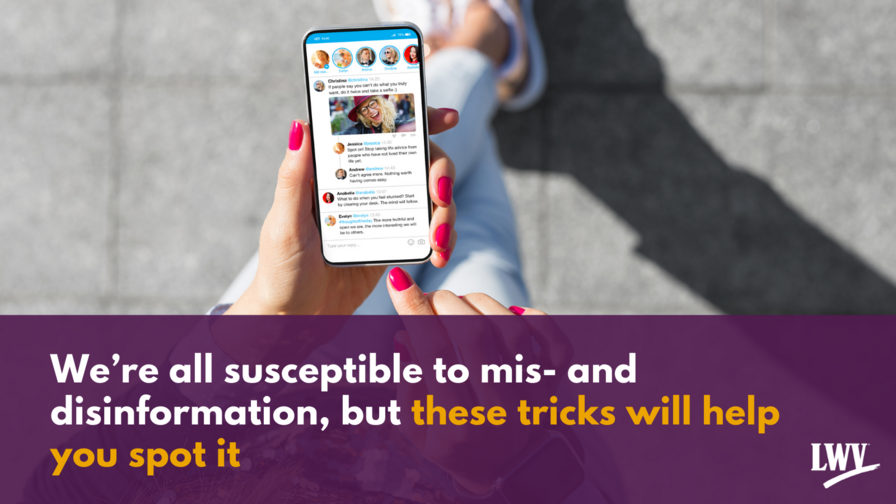Your Guide to Mis- and Disinformation
Mis- and dis-information are two of the most insidious tools used to undermine our democracy and the value of every person’s voice. Learn how to recognize them and stop them in their tracks.
What Are Mis- and Disinformation?
Misinformation: inadvertently sharing false information without the intent to harm
Ex. Your sister says that the latest local bill will raise taxes because that’s what she heard from a trusted friend.
Disinformation: intentionally sharing false information with the intent to harm
Ex. Your sister lies that the latest local bill will raises taxes because she knows that’s the only way you won’t support it.
While disinformation may seem like the worse of the two, it’s frighteningly easy to spread misinformation. Remember the game “telephone” and how it shows that our messages get distorted over time? Every day, we play telephone in our face-to-face conversations, over social media, and more, with important political information.
How Can You Spot Mis- and disinformation?
We’re all susceptible to mis- and disinformation, but the following steps will help you spot it before you take part in its spread:
- Research the source: Who’s sharing this information? If it’s online, does the website sound familiar or have any political affiliations? If it’s in-person, is this individual a frequent exaggerator, or do they have a job/experience that would give them insider info?
- Check the date: It’s easy to get incensed over an article on Twitter...only to realize it was published years ago and no longer applies.
- Cross-check: Are reliable news sources reporting the same information? If not, it’s unlikely that your smaller source just happened to get a super-exclusive, juicy scoop.
- Read past the headline: You know how tabloids post scandalous headlines and follow them with articles that are relatively mundane? Unfortunately, political outlets do that too. It’s easy to take a snippet out of context to make an article look like it will be more dramatic than it actually is.
- Question emotionally charged content: Is the person or outlet sharing this information using emotionally manipulative language to get you upset or excited? That’s a red flag. Reliable sources let the facts fuel your response, not emotional language. Check out some examples of loaded language.
How to Stop Mis- and Disinformation
Once you’ve spotted inaccurate information, follow these tips to keep it from spreading (and get it removed):
- Don’t engage: It may be tempting to comment on an inaccurate Facebook post about how wrong it is, or to click on it to read all of the writer’s claims, but don’t! Every like, click, share, and comment contributes to the piece’s rate of engagement, which tells whatever website you’re on that it’s good content that they should show to more people. Many outlets take advantage of this, posting headlines that they know will have you firing back a response – because good or bad, that response will promote their piece.
- Share correct information: For every incorrect piece of info you see or hear, try to share one that’s correct. Instead of creating further discourse around something you don’t want people to hear, get people talking about what you do want them to hear.
- Report when needed: Whenever you see disinformation online, report it to ReportDisinfo.org. You can also report most social media posts to the platforms themselves.
Interested in learning more about mis- and disinformation? Stay in touch to get updates on our Democracy Truth Project, an effort to advance public understanding of our government and reduce inaccurate information.
The Latest from the League
‘Women Power Democracy,’ the new programmatic focus of the League of Women Voters, will advance a stronger, more representative American democracy.
VOTE411, the League of Women Voters’ one-stop-shop for nonpartisan election information, this week was announced as a Webby Awards Nominee.
Sign Up For Email
Keep up with the League. Receive emails to your inbox!
Donate to support our work
to empower voters and defend democracy.







